Wisdom Tooth Surgical Extraction in East Gosford, Central Coast, NSW.
Our experienced team of dentists in East Gosford are committed to providing you with quality dental services on the Central Coast.
Wisdom teeth are the last teeth to erupt at the back of your mouth. At VC Dental we can extract impacted wisdom teeth to prevent them causing pain and discomfort. We perform simple and surgical extractions, both of which can be completed under IV (sleep) sedation.
Call us today to discuss your dental needs, or click this button to book an appointment online now.
What are wisdom teeth?
Wisdom teeth, also called ‘third molars’ are the last teeth to erupt at the back of your mouth.
They usually erupt between the ages of 16-24 years.
Most people have four wisdom teeth; two in the upper jaw and two in the lower jaw. However, some people do not develop wisdom teeth at all, and others can be missing one or more. If you don’t have all four wisdom teeth it’s nothing to worry about.
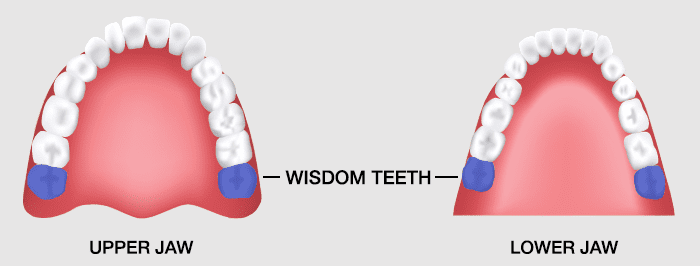
Why is wisdom teeth removal necessary?
In some cases, wisdom teeth can erupt without any complications.
However, in many cases there is not enough space at the rear of the mouth/in the jaws to allow wisdom to fully erupt in the correct position and be functional.
This causes the wisdom teeth to remain partly or completely below the gum surface, referred to as being wedged or ‘impacted’. Impactions can involve the soft tissue (gums), hard tissue (bone), or both.
Impacted wisdom teeth are not able to erupt at the correct angle, and do not have adequate room.
You do not need your wisdom teeth, so if they become impacted it is recommended to remove them before any discomfort, pain or infection eventuates.
Consequences of wisdom teeth impaction
Problems associated with impacted wisdom teeth include:
- Tooth decay and/or gum infection. Wisdom teeth can grow at angles making them difficult to clean and there may be a ‘pocket’ between the wisdom tooth and the gum, or the wisdom tooth and the adjacent tooth (second molar) that traps food and bacteria. This can also cause decay on the second molar.
- Tooth crowding. If wisdom teeth erupt at an angle, they can put pressure on the adjacent teeth, causing them to shift position which can then affect other teeth and cause overcrowding.
- Swollen or irritated cheeks and gums which can be caused by infection, or the pressure of wisdom teeth erupting at an angle.
- Cysts. They usually occur in the mandible (lower jaw) when the body forms a sack of tissues or clear fluid around the unerupted wisdom tooth.
Symptoms of wisdom teeth impaction
- Redness and swelling of the gums around or behind the second molar (tooth adjacent to the wisdom tooth). The gums may also be painful and can bleed.
- Slow healing of the soft tissue (gum) over the crown (top) of the wisdom tooth.
- Swelling in the pharyngeal regions (side throat area) and at the angle of the mandible (side of the jawbone).
- Inability to bite together.
- Difficulty opening your mouth.
- Feeling pressure in your mouth (usually on the adjacent second molars).
- Pain in the TMJ (temporomandibular joint – just in front of your ear).
- Pain in the muscles of mastication (your ‘chewing’ muscles, around your jaw).
How we assess wisdom teeth impaction
We take a digital OPG (Orthopantomogram) which is a type of radiograph (x-ray) that shows all the teeth, the upper and lower jawbones, and the sinus cavity in a single image.
This will allow us to assess the position and level of development of your wisdom teeth, as well as their location in relation to your other teeth, nerves and sinus cavity.
If they need to be removed, we use this x-ray image to select the safest and most effective method of tooth removal.
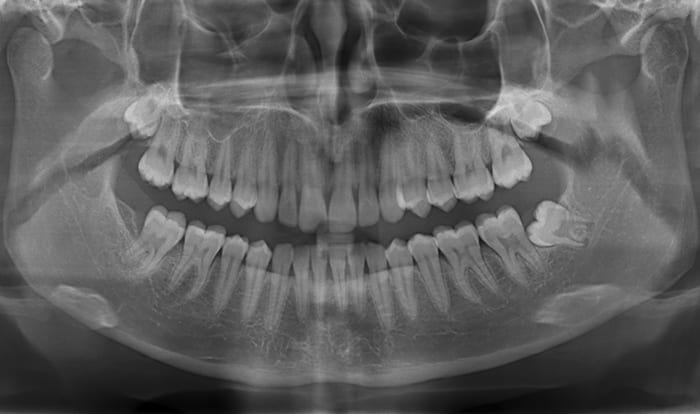
Types of impacted wisdom teeth
Types of wisdom teeth impactions include:
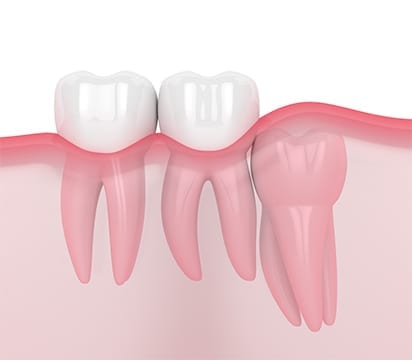
Normal vertical or upright impactions.
These grow at a correct upwards angle, but become trapped within the jawbone.
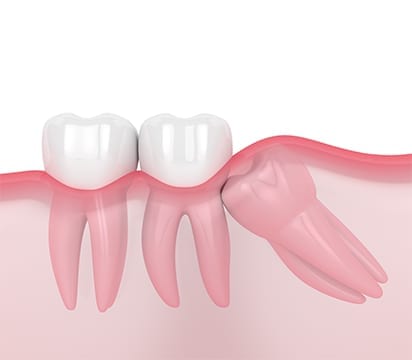
Mesio-angular impactions
These grow at an angle towards the adjacent tooth (second molar). The tooth is leaning forward and creates a pocket behind the second molar.

Disto-angular impactions
These grow at an angle towards the back of the mouth. The tooth is leaning backwards into the lower jaw. These require a more complex extraction procedure due to the required amount of bone removal.
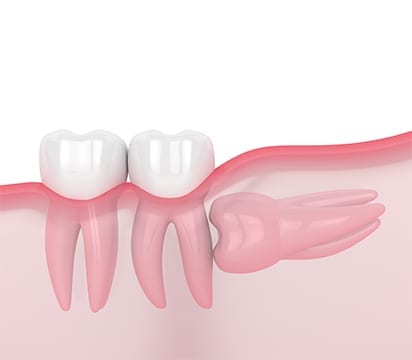
Horizontal impactions.
This is where the tooth is lying completely flat, and the crown (top part of the tooth) is usually resting against the back of the second molar. These types of impacted wisdom teeth lay at right angles to the rest of the dentition (teeth).
A wisdom tooth that is partially visible is called a partially-erupted wisdom tooth. In these cases part of the crown (top part of the tooth) is visible:
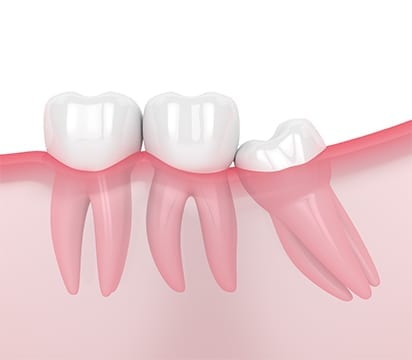
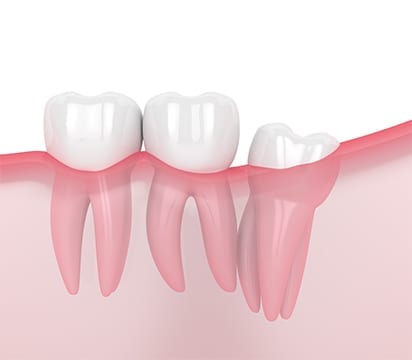
Wisdom teeth extraction procedure
All our surgical procedures can be performed under a local anaesthetic, oral sedation, inhalation sedation or IV sedation. For more information about our sedation options please click here.
If the wisdom teeth have completely erupted at the correct angle (but need to be removed due to the patient not having adequate space in the jawbone), we can usually perform a simple extraction.
If the wisdom teeth are fully impacted, or impacted and partially erupted, we usually need to perform a surgical extraction.
Simple Extractions
A simple tooth extraction is performed when the tooth is able to be removed completely intact (in one piece). The process is quite straightforward and involves the use of dental instruments to remove the tooth. This procedure is generally well tolerated under local anaesthetic (to numb the affected area) where you will feel pressure, but not any pain. However, we do offer stronger sedative options if desired.
Surgical Extractions
A surgical extraction is performed when the tooth cannot be removed intact due to the angle it is growing in, or due to it being embedded in the jawbone. It is a more complex procedure which may include minor oral surgery. It involves raising the gum to expose the whole tooth (and can require the careful removal of some surrounding bone), before the tooth is removed in fragments and the incision is closed with sutures. Whilst this procedure can also be performed pain-free under local anaesthetic, we offer a range of sedation options to ensure you are comfortable and relaxed.
Please note, any surgical or invasive procedure carries risks. Before proceeding you should obtain personal advice from an appropriately qualified health practitioner.


